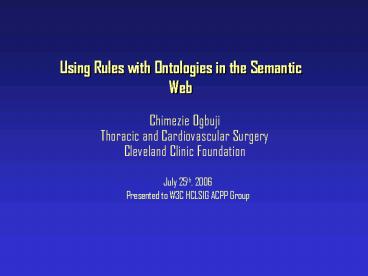Using Rules with Ontologies in the Semantic Web - PowerPoint PPT Presentation
1 / 15
Title:
Using Rules with Ontologies in the Semantic Web
Description:
In SWRL's abstract syntax: ... DL abstracts Knowledge Representation at the expense of the reasoning mechanism. ... Complexity and Abstraction (Revisited) ... – PowerPoint PPT presentation
Number of Views:80
Avg rating:3.0/5.0
Title: Using Rules with Ontologies in the Semantic Web
1
Using Rules with Ontologies in the Semantic Web
- Chimezie OgbujiThoracic and Cardiovascular
SurgeryCleveland Clinic Foundation
July 25th, 2006 Presented to W3C HCLSIG ACPP Group
2
Rule Languages
- RuleML
- SWRL
- Notation 3 (N3)
3
Semantic Web Reasoners
- Closed World Machine (CWM)
- Euler
- Pychinko
- RDFEngine
- Jena
4
Using Rules to Describe Rules
- A Rule consists of a body (antecedent) and a head
(consequent) - In N3
- ?X has ?body. ?X has ?head. body logimplies
head gt ?X a Rule - In SWRLs abstract syntax
- Implies(Antecedent(has(I-variable(X),
I-variable(body) has(I-variable(X),
I-variable(head)) logImplies(I-variable(body),
I-variable(head))) Consequent(Rule(I-variable(X)))
5
Origin / Background of Rules
- Logic Programming
- Production systems (RETE, etc.)
- Prolog
- SQL
- Horn-clause Logic
- Efficient theorem proving, and reasoning
6
Complexity and Abstraction
- Kurt Cagle
- You can never eliminate complexity from a
system, you can only move it from place to place - Important point regarding how / why rules are
used with ontology languages
7
DL Semantics as Analogy for Rules
- Description Logics (DL)
- Strict subset of FOL with decidability in mind
- DL are more palatable and (therefore) more
ubiquitous - Ontology language constructs correspond to DL
constructs - Some DL (ontology) reasoning can be done via
explicit rules
8
Some DL Semantics as N3 Rules
- Transitive Roles
- ?P a owlTransitiveProperty. ?X ?P ?Y. ?Y ?P ?Z
gt ?X ?P ?Z - Class inclusion
- ?B rdfssubClassOf ?C. ?A rdfssubClassOf ?B gt
?A rdfssubClassOf ?C. - Inverse Roles
- ?P owlinverseOf ?Q. ?S ?P ?O gt ?O ?Q ?S.
- Functional Restrictions
- ?P a owlFunctionalProperty. ?S ?P ?X. ?S ?P ?Y
gt ?X owlsameAs ?Y.
9
Restriction on Expressivenes
- Certain implications cannot be expressed in DL
- Individuals who live and work at the same
location are Home Workers - In N3
- ?X work ?Y. ?X live ?Z. ?Z located ?W. ?Y
located ?Y gt ?X a HomeWorker
10
Restriction on Expressiveness (Cont.)
- Specific logical restrictions (Horn logic) make
it difficult to express certain statements - Every person has a father (known or unknown)
- However, this is straight forward in OWL (and
Description Logics) - Person a owlClass
- rdfssubClassOf
- a owlRestriction
- owlonProperty father
- owlcardinality 1.
11
Rule Inference Methods
- Given
- Set of rules
- Set of facts
- Backward chaining is goal-oriented
- Question can a fact be inferred from the rules
and existing facts? - Forward chaining exhaustively infers new facts
from the rules - The resulting facts combined with the original
facts are often referred to as the closure
12
Concerns with Reasoning
- Logic Programming reasoners and algorithms are
more mature - RETE algorithm for production (forward chaining)
systems - Euler cycle detection for backward chaining
inference - Logic Programming systems are at the mercy of the
explicit rules
13
Complexity and Abstraction (Revisited)
- Kurt Cagle
- You can never eliminate complexity from a
system, you can only move it from place to place - DL abstracts Knowledge Representation at the
expense of the reasoning mechanism. - DL reasoners are implemented to support only a
limited kind of inference class subsumption and
consistency detection.
14
Compromise
- Use DL semantics where the domain falls nicely
into Categories / Roles and decidability is an
issue - Use rules everywhere else
- The combination covers the full spectrum of
expressiveness and decidability - Including both in the thought process improves
Knowledge Engineering - Some DL semantics can be expressed as rules to
take advantage of efficient pattern matching
algorithms
15
References
- Description Logic Programs Combining Logic
Programs with Description Logic - http//citeseer.ist.psu.edu/grosof03description.ht
ml - Description Logic Complexity Navigator
- http//www.cs.man.ac.uk/ezolin/logic/complexity.h
tml - Web Ontology Reasoning with Logic Databases
- http//www.ubka.uni-karlsruhe.de/vvv/2004/wiwi/2/2
.pdf - Eulers RDF Plus OWL N3 Rules
- http//www.agfa.com/w3c/euler/rpo-rules.n3
- Description Logics as Ontology Languages for the
Semantic Web - http//citeseer.ist.psu.edu/baader03description.ht
ml































